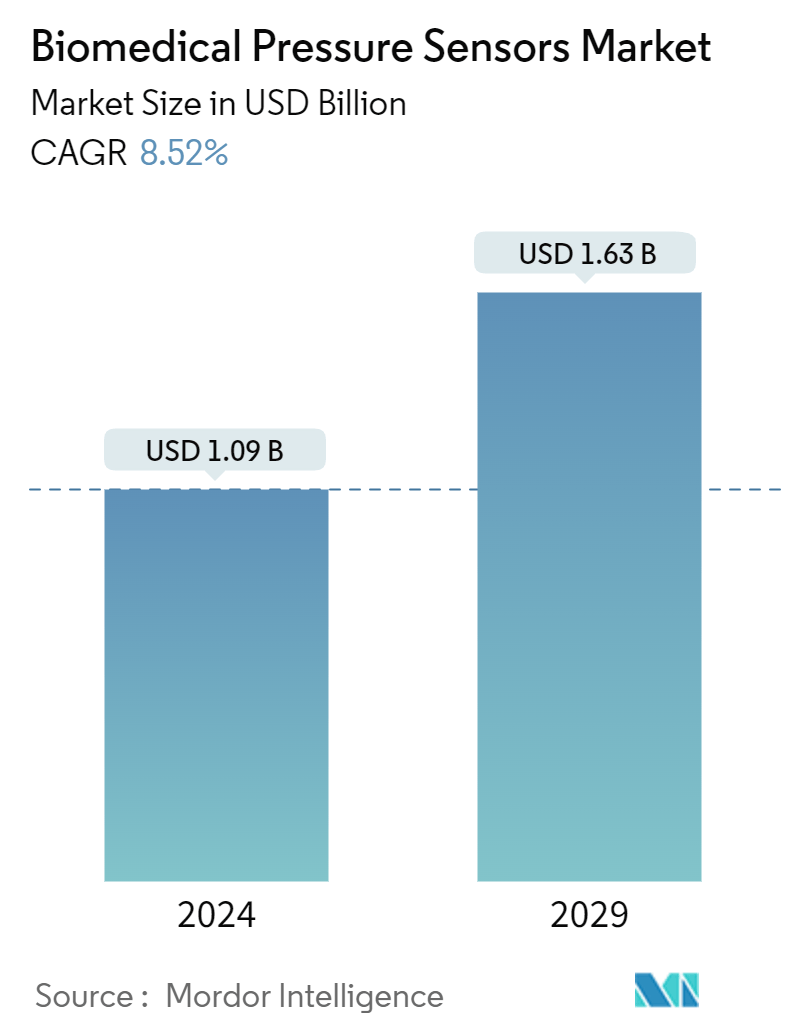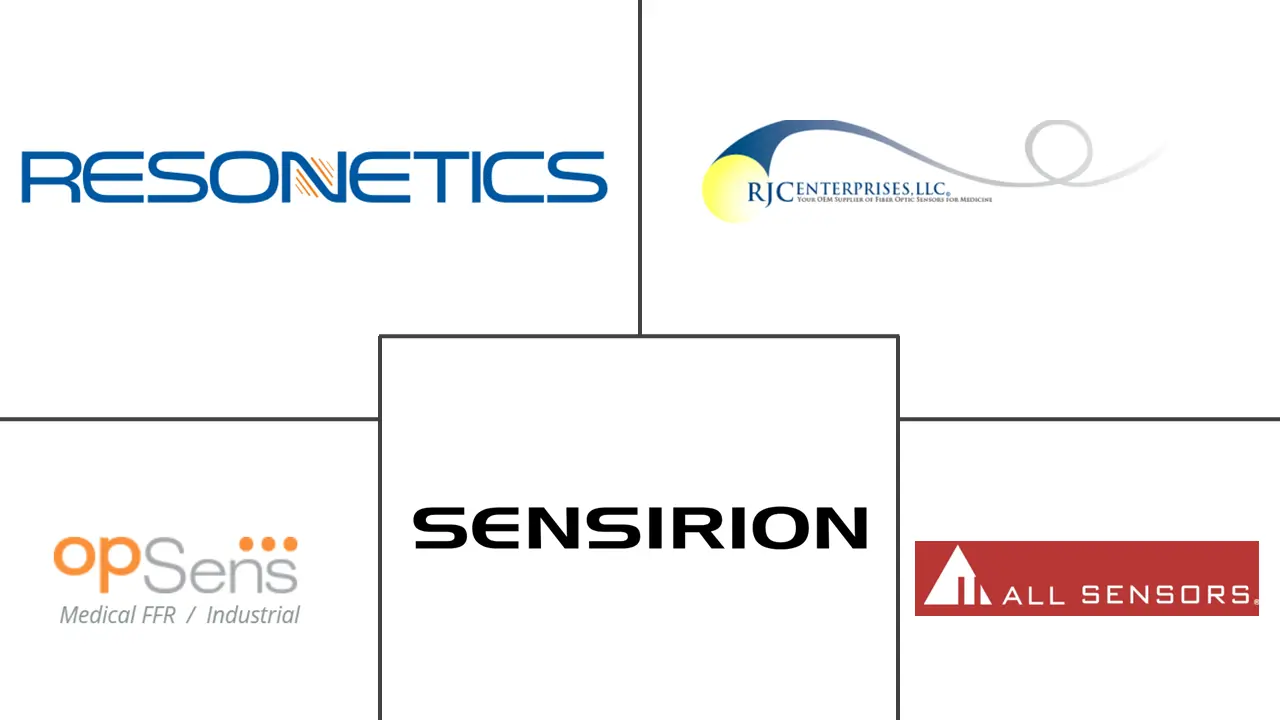Market Size of Biomedical Pressure Sensors Industry

| Study Period | 2019 - 2029 |
| Market Size (2024) | USD 1.09 Billion |
| Market Size (2029) | USD 1.63 Billion |
| CAGR (2024 - 2029) | 8.52 % |
| Fastest Growing Market | Asia Pacific |
| Largest Market | North America |
| Market Concentration | Medium |
Major Players
*Disclaimer: Major Players sorted in no particular order |
Biomedical Pressure Sensors Market Analysis
The Biomedical Pressure Sensors Market size is estimated at USD 1.09 billion in 2024, and is expected to reach USD 1.63 billion by 2029, growing at a CAGR of 8.52% during the forecast period (2024-2029).
- Biomedical sensors are the result of combining electronic information technology and biomedicine, and they remain highly dynamic due to the growth of multidisciplinary collaborations. Biomedical pressure sensors are unique electronic devices capable of converting pressure signals into measurable electric signals. These sensors play a crucial role in a wide range of medical diagnostic and therapeutic equipment and instruments. The ongoing progress in the biomedical industry is expected to boost the need for pressure sensors.
- Sensor technology has undergone significant evolution, leading to its integration into advanced medical devices. This evolution has not only enabled the creation of miniaturized and portable medical devices but also enhanced their effectiveness. For instance, biomedical pressure sensors can now monitor a patient's condition across a wide spectrum of scenarios. From assessing the efficacy of oxygen therapy in concentrators to automating precise drug infusions in pumps and even measuring blood pressure, these sensors play a pivotal role.
- Moreover, pressure sensors are now a vital component of medical care, offering precise and stable measurement of critical pressure levels in gases and liquids within the body and during patient treatments. Advancements in technology will lead to the development of more sophisticated and smaller biomedical equipment while also reducing the cost of home-use devices. This will result in an improved quality of life for the aging population. These significant developments are expected to enhance market opportunities.
- Biosensors play a crucial role in the healthcare industry by facilitating the sensing, detection, and monitoring of a wide range of disorders in individuals. The increasing incidence of diabetes and chronic diseases worldwide is a key driver behind the growth of the biosensors market. These innovative devices are integrated into medical wearables to accurately measure blood glucose levels, enabling the early detection of diabetes. Consequently, this factor significantly contributes to the advancement and expansion of biosensors.
- The market is witnessing robust growth, propelled by rising demand for superior patient care. This demand surge is a direct outcome of heightened global consumer awareness and escalating healthcare spending. With increased healthcare investments, especially in cutting-edge medical devices and infrastructure—where pressure sensors play a pivotal role—the market is poised for further expansion. With the increasing demand for these sensors in the medical industry, several companies are significantly investing in various product launches.
- For instance, in April 2023, Superior Sensor Technology unveiled specialized biomedical pressure sensors tailored for medical ventilators. These sensors integrate advanced over-sampling methods, elevating their dynamic range. This enhancement empowers mechanical ventilators to harness sensor outputs directly, eliminating the necessity for subsequent over-sampling procedures. Such vendor developments are expected to drive the market's growth significantly.
- Remote patient monitoring stands out as a burgeoning trend in healthcare, propelling the uptake of digital technologies and cutting-edge medical devices for electronic health data recording. Patients utilize wearables to monitor their health and activity, while clinicians employ them for remote monitoring. The synergy between medical devices, patient wearables, EMRs, smartphones, and telehealth platforms not only streamlines operations but also enhances clinical decision-making. Leading wearable manufacturers are enhancing their products by integrating advanced health monitoring features, thereby fueling the demand for biomedical pressure sensors.
- Nevertheless, the technical constraints of biomedical pressure sensors, including the impact of the environment on detection capabilities and sensor readings, continue to be significant obstacles to the expansion of the market under examination. Moreover, the necessity for product distinctiveness and awareness, particularly in emerging regions, along with the expense of the sensors, further hinders the growth of the market being studied.
Biomedical Pressure Sensors Industry Segmentation
Biomedical pressure sensors are used in applications that target three major respiratory disorders: asthma, chronic obstructive pulmonary disease, and sleep apnea. They are used in diagnostic equipment to measure the pressure of air expelled from the lungs and therapeutic equipment, such as oxygen therapy equipment, nebulizers, and ventilators.
The biomedical pressure sensors market is segmented by technology, application, and geography. By technology, the market is segmented into self-calibrating, fiber-optic, telemetric, capacitive, wireless passive, and piezoresistive. By application, the market is divided into diagnostic, therapeutic, medical imaging, monitoring, fitness and wellness, and other applications. By geography, the market is segmented into North America, Europe, Asia-Pacific, Latin America, and Middle East and Africa. The market sizing and forecasts are provided in terms of value (USD) for all the above segments.
| By Technology | |
| Self-calibrating | |
| Fiber-optic | |
| Telemetric | |
| Capacitive | |
| Wireless Passive | |
| Piezoresistive |
| By Application | |
| Diagnostic | |
| Therapeutic | |
| Medical Imaging | |
| Monitoring | |
| Fitness and Wellness | |
| Other Applications |
| By Geography | |
| North America | |
| Europe | |
| Asia-Pacific | |
| Latin America | |
| Middle East and Africa |
Biomedical Pressure Sensors Market Size Summary
The biomedical pressure sensor market is poised for significant growth, driven by the increasing demand for advanced medical devices and enhanced patient care. These sensors play a crucial role in various medical diagnostic and therapeutic equipment, transforming pressure signals into measurable electric signals. The evolution of sensor technology has led to the development of miniaturized and portable medical devices, which are essential for monitoring patient conditions and automating drug delivery. The rising global healthcare expenditure and consumer awareness are key factors propelling the market, as they encourage investments in medical infrastructure where these sensors are extensively used. However, challenges such as environmental influences on sensor readings, the need for product differentiation, and cost considerations, particularly in developing regions, pose constraints to market growth.
The Asia-Pacific region is expected to witness robust growth in the biomedical pressure sensor market, fueled by increased healthcare sector applications and government investments in medical infrastructure. Emerging economies like China, South Korea, and India are contributing significantly to this growth, supported by government initiatives in mHealth products and the adoption of IoT and advanced technologies. The region's market expansion is further bolstered by the rising prevalence of chronic disorders and heightened awareness of medical sensors. Additionally, the sensor industry faces competitive challenges due to a limited number of manufacturers, with market leaders influencing overall dynamics through strategic expansions and collaborations. Recent advancements, such as Superior Sensor Technology's innovations for medical ventilators and partnerships like that of LCSC and Sensirion, highlight the ongoing efforts to enhance sensor capabilities and market reach.
Biomedical Pressure Sensors Market Size - Table of Contents
-
1. MARKET INSIGHTS
-
1.1 Market Overview
-
1.2 Industry Attractiveness - Porter's Five Forces Analysis
-
1.2.1 Bargaining Power of Suppliers
-
1.2.2 Bargaining Power of Buyers
-
1.2.3 Threat of New Entrants
-
1.2.4 Threat of Substitutes
-
1.2.5 Degree of Competition
-
-
1.3 Overview of Pressure Mapping Systems
-
1.4 Impact of Microeconomics Factors on the Market
-
-
2. MARKET SEGMENTATION
-
2.1 By Technology
-
2.1.1 Self-calibrating
-
2.1.2 Fiber-optic
-
2.1.3 Telemetric
-
2.1.4 Capacitive
-
2.1.5 Wireless Passive
-
2.1.6 Piezoresistive
-
-
2.2 By Application
-
2.2.1 Diagnostic
-
2.2.2 Therapeutic
-
2.2.3 Medical Imaging
-
2.2.4 Monitoring
-
2.2.5 Fitness and Wellness
-
2.2.6 Other Applications
-
-
2.3 By Geography
-
2.3.1 North America
-
2.3.2 Europe
-
2.3.3 Asia-Pacific
-
2.3.4 Latin America
-
2.3.5 Middle East and Africa
-
-
Biomedical Pressure Sensors Market Size FAQs
How big is the Biomedical Pressure Sensors Market?
The Biomedical Pressure Sensors Market size is expected to reach USD 1.09 billion in 2024 and grow at a CAGR of 8.52% to reach USD 1.63 billion by 2029.
What is the current Biomedical Pressure Sensors Market size?
In 2024, the Biomedical Pressure Sensors Market size is expected to reach USD 1.09 billion.

